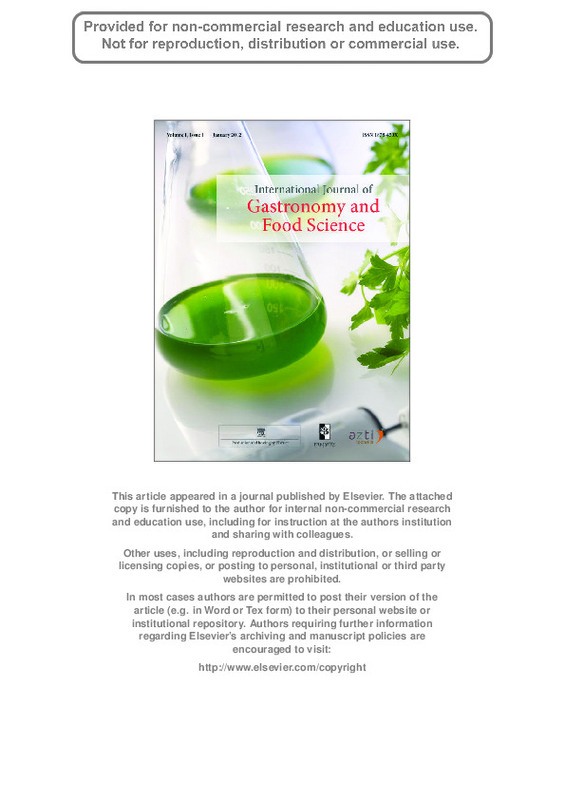JavaScript is disabled for your browser. Some features of this site may not work without it.
Buscar en RiuNet
Listar
Mi cuenta
Estadísticas
Ayuda RiuNet
Admin. UPV
Improvement of a culinary recipe by applying sensory analysis: Design of the New Tarte Tatin
Mostrar el registro sencillo del ítem
Ficheros en el ítem
| dc.contributor.author | García Segovia, Purificación
|
es_ES |
| dc.contributor.author | Barreto Palacios, Vivian Janeth
|
es_ES |
| dc.contributor.author | Iborra Bernad, María del Consuelo
|
es_ES |
| dc.contributor.author | Andrés Bello, María Desamparados
|
es_ES |
| dc.contributor.author | González Carrascosa, Rebeca
|
es_ES |
| dc.contributor.author | Bretón, Jorge
|
es_ES |
| dc.contributor.author | Martínez Monzó, Javier
|
es_ES |
| dc.date.accessioned | 2017-01-27T11:59:53Z | |
| dc.date.available | 2017-01-27T11:59:53Z | |
| dc.date.issued | 2012-01 | |
| dc.identifier.issn | 1878-450X | |
| dc.identifier.uri | http://hdl.handle.net/10251/77407 | |
| dc.description.abstract | During the last decade, knowledge of food science and technology has been applied to Haute Cuisine obtaining great benefits. The most important chefs of the world are keen on gaining knowledge about the physicochemical changes to food after any culinary process, as well as the art of combining different flavors in order to obtain both new flavors and new textures. This could allow chefs to develop new processes and hence gain a competitive advantage in their restaurants. Sensory analysis can be a good tool to develop new products in a restaurant, in particular, new desserts. Consumer response to the sensory properties of food (particularly appearance, flavor, aroma, taste and texture) is an important factor in determining the success of new products. Therefore, the aim of this work was to develop a new dessert, based on the classic French dessert ‘‘Tarte Tatin’’ (an upside down fruit tart, usually made with apples), using sensory analysis as a crucial tool in its design. The preference for different apple products prepared using different methods of cooking, was evaluated by a consumer panel and the statistical analysis showed significant differences (a ¼ 0.05) between the processes | es_ES |
| dc.language | Inglés | es_ES |
| dc.publisher | Elsevier | es_ES |
| dc.relation.ispartof | International Journal of Gastronomy and Food Science | es_ES |
| dc.rights | Reconocimiento - No comercial - Sin obra derivada (by-nc-nd) | es_ES |
| dc.subject | Sensory analysis | es_ES |
| dc.subject | Cook-vide | es_ES |
| dc.subject | Sous-vide | es_ES |
| dc.subject | Apple tart | es_ES |
| dc.subject.classification | TECNOLOGIA DE ALIMENTOS | es_ES |
| dc.title | Improvement of a culinary recipe by applying sensory analysis: Design of the New Tarte Tatin | es_ES |
| dc.type | Artículo | es_ES |
| dc.identifier.doi | 10.1016/j.ijgfs.2011.11.011 | |
| dc.rights.accessRights | Abierto | es_ES |
| dc.contributor.affiliation | Universitat Politècnica de València. Departamento de Tecnología de Alimentos - Departament de Tecnologia d'Aliments | es_ES |
| dc.description.bibliographicCitation | García Segovia, P.; Barreto Palacios, VJ.; Iborra Bernad, MDC.; Andrés Bello, MD.; González Carrascosa, R.; Bretón, J.; Martínez Monzó, J. (2012). Improvement of a culinary recipe by applying sensory analysis: Design of the New Tarte Tatin. International Journal of Gastronomy and Food Science. 1(1):54-60. doi:10.1016/j.ijgfs.2011.11.011 | es_ES |
| dc.description.accrualMethod | S | es_ES |
| dc.relation.publisherversion | https://dx.doi.org/10.1016/j.ijgfs.2011.11.011 | es_ES |
| dc.description.upvformatpinicio | 54 | es_ES |
| dc.description.upvformatpfin | 60 | es_ES |
| dc.type.version | info:eu-repo/semantics/publishedVersion | es_ES |
| dc.description.volume | 1 | es_ES |
| dc.description.issue | 1 | es_ES |
| dc.relation.senia | 215014 | es_ES |








